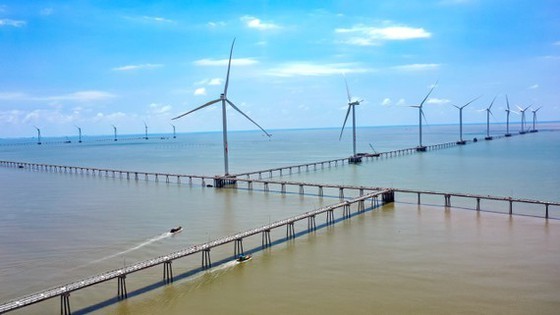 Dong Hai wind power project in Tra Vinh Province. (Photo: SGGP)
Dong Hai wind power project in Tra Vinh Province. (Photo: SGGP)
Speaking at the meeting, held in Hanoi on April 26 under the chair of Deputy Prime Minister Le Van Thanh, Minister of Industry and Trade Nguyen Hong Dien said the plan also targets a balance in electricity generation between regions and encourages the development of other fuels like hydrogen and ammonia.
Dr. Ngo Tuan Kiet, Director of the Vietnam Academy of Science and Technology, said data on wind power, both offshore and onshore, have been updated in the plan. However, the updated figures from international organizations are not enough and it still requires exclusive studies and assessments.
With the inclusion of Prime Minister Pham Minh Chinh’s commitments at the 26th United Nations Climate Change Conference of the Parties (COP26), the plan has opened up opportunities for the development of wind power, especially offshore wind power, according to Associate Prof. Dr. Pham Hoang Luong.
He stressed the need for Vietnam to soon set out a national marine space planning scheme by 2045 which stipulates the sustainable management and use of the marine space to serve economic activities.
Closing the meeting, Deputy PM Thanh expressed his approval for assessments of the State Appraisal Council that PDP VIII has been prepared thoroughly and scientifically.
The plan has also been sketched out in line with Resolution No.55 of the Politburo on the national energy development strategy by 2030 with a vision towards 2045, he said.
Under the plan, the national power capacity from now until 2030 would be 146,000 megawatts (MW), 35,000 MW less than the amount in the previous version, he said, noting that it aims to cut coal-fired power and increase renewable energy.
The Deputy PM assigned the Ministry of Industry and Trade (MoIT) and other ministries and agencies to collect opinions of the council and finalize the draft plan, which should be submitted to the PM for approval in May.
Mechanisms and policies, except for legal regulations, should not be integrated in the draft plan, he said, asking the MoIT to develop an implementation scheme under a set roadmap.
Dr. Ngo Tuan Kiet, Director of the Vietnam Academy of Science and Technology, said data on wind power, both offshore and onshore, have been updated in the plan. However, the updated figures from international organizations are not enough and it still requires exclusive studies and assessments.
With the inclusion of Prime Minister Pham Minh Chinh’s commitments at the 26th United Nations Climate Change Conference of the Parties (COP26), the plan has opened up opportunities for the development of wind power, especially offshore wind power, according to Associate Prof. Dr. Pham Hoang Luong.
He stressed the need for Vietnam to soon set out a national marine space planning scheme by 2045 which stipulates the sustainable management and use of the marine space to serve economic activities.
Closing the meeting, Deputy PM Thanh expressed his approval for assessments of the State Appraisal Council that PDP VIII has been prepared thoroughly and scientifically.
The plan has also been sketched out in line with Resolution No.55 of the Politburo on the national energy development strategy by 2030 with a vision towards 2045, he said.
Under the plan, the national power capacity from now until 2030 would be 146,000 megawatts (MW), 35,000 MW less than the amount in the previous version, he said, noting that it aims to cut coal-fired power and increase renewable energy.
The Deputy PM assigned the Ministry of Industry and Trade (MoIT) and other ministries and agencies to collect opinions of the council and finalize the draft plan, which should be submitted to the PM for approval in May.
Mechanisms and policies, except for legal regulations, should not be integrated in the draft plan, he said, asking the MoIT to develop an implementation scheme under a set roadmap.
























